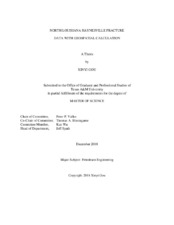| dc.description.abstract | Known as one of the most productive shale gas plays in the US, the Haynesville shale gas play covers 9,000 square miles from East Texas to North Louisiana. With horizontal wells and multi-stage hydraulic fracturing, gas production has increased rapidly. The Haynesville shale is a geologically unique dry gas play with relatively large depth, high temperature, high reservoir pressure gradient, ultralow permeability, and soft formations. The harsh conditions have brought challenges in drilling and completion and have made the gas production very sensitive to the gas price. Under these circumstances, top priority strategies in the shale’s development are to cut the cost and increase reserves. The object of this study is to perform a regional investigation of the effect of drilling and completion practice on the cumulative production.
There has been much debate about the relationship between proppant and fracturing fluid usage and cumulative production. Some articles report more proppant and fracturing fluid loading greatly boosts their production while other researches state that there is no relationship among them. The controversial findings usually come from well-based analysis, where the geospatial information regarding the analyzed well and its neighbors is either totally neglected or extremely simplified. The basic hypothesis of this work is that the role of completion parameters can be better understood if detailed geospatial information is used in the analysis. Using production data from Drillinginfo and completion data from the FracFocus website, we create a visual presentation of the most prolific parish (De Soto Parish) of the Haynesville shale play. The study area is decomposed into 640-acre (pseudo-)sections. Wells are assigned to the sections based on their subsurface path. If a well’s path falls into more than one section, geospatial weight percentages are calculated. Then the main completion and production variables are calculated for each section using the pre-determined geo-spatial weights. This allows us to conduct a section-based analysis of the effect of completion variables on cumulative production. We perform section analysis and focus on finding potential correlations. Those correlations will lead us to analyze current development strategy and suggest its improvement in the future, depending on the changing gas-price environment. | en |


